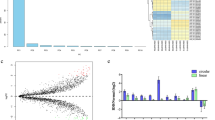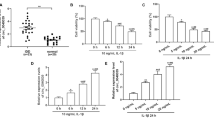Abstract
Intervertebral disc disease (IDD) is a primary cause of low back pain, affecting 5% of individuals. Previous study have shown that dual-specificity (Thr/Tyr) phosphatase 1 (DUSP1) regulates p38 MAPK activity and DUSP1 level is regulated by ubiquitination. As an E3 ubiquitin-protein ligase, UBR3 has been shown to regulate a variety of biological processes through ubiquitination. However, the role of UBR3/DUSP1/p38 in IDD remains to be elucidated. In the current study, we found that UBR3 was significantly increased in the nucleus pulposus tissues of IDD patients and was correlated with IDD severity. Silencing UBR3 promoted the growth, inhibited apoptosis, and inhibited inflammation in primary NPCs. Mechanism study suggested that UBR3 exerted its effects through p38. Co-immunoprecipitation assay indicated that UBR3 promoted DUSP1 ubiquitination. Overexpression of DUSP1 reversed the effect of UBR3 overexpression. Our data also supported that UBR3 was positively correlated with p-p38, but negatively correlated with DUSP1 in IDD. In summary, UBR3 promotes inflammation and apoptosis via inhibiting the p38 signaling pathway by DUSP1 ubiquitination in the NPCs of IDD patients. These findings highlight the importance of UBR3/DUSP1/p38 signaling pathway in IDD and provide new insights for the prevention and treatment of IDD.






Similar content being viewed by others
Data availability statement
All data generated or analyzed during this study are included in this published article and its supplementary information files.
References
Dowdell J, Erwin M, Choma T, Vaccaro A, Iatridis J, Cho SK. Intervertebral disk degeneration and repair. Neurosurgery. 2017;80:S46–54. https://doi.org/10.1093/neuros/nyw078.
Boos N, Weissbach S, Rohrbach H, Weiler C, Spratt KF, Nerlich AG. Classification of age-related changes in lumbar intervertebral discs: 2002 Volvo award in basic science. Spine. 2002;27:2631–44. https://doi.org/10.1097/00007632-200212010-00002.
Virtanen IM, Karppinen J, Taimela S, Ott J, Barral S, Kaikkonen K, Heikkila O, Mutanen P, Noponen N, Mannikko M, Tervonen O, Natri A, Ala-Kokko L. Occupational and genetic risk factors associated with intervertebral disc disease. Spine. 2007;32:1129–34. https://doi.org/10.1097/01.brs.0000261473.03274.5c.
Noponen-Hietala N, Virtanen I, Karttunen R, Schwenke S, Jakkula E, Li H, Merikivi R, Barral S, Ott J, Karppinen J, Ala-Kokko L. Genetic variations in IL6 associate with intervertebral disc disease characterized by sciatica. Pain. 2005;114:186–94. https://doi.org/10.1016/j.pain.2004.12.015.
Pattappa G, Li Z, Peroglio M, Wismer N, Alini M, Grad S. Diversity of intervertebral disc cells: phenotype and function. J Anat. 2012;221:480–96. https://doi.org/10.1111/j.1469-7580.2012.01521.x.
Urban JP, Smith S, Fairbank JC. Nutrition of the intervertebral disc. Spine. 2004;29:2700–9. https://doi.org/10.1097/01.brs.0000146499.97948.52.
Molinos M, Almeida CR, Caldeira J, Cunha C, Goncalves RM, Barbosa MA. Inflammation in intervertebral disc degeneration and regeneration. J R Soc Interface. 2015;12:20150429. https://doi.org/10.1098/rsif.2015.0429.
Roberts S, Evans H, Trivedi J, Menage J. Histology and pathology of the human intervertebral disc. J Bone Joint Surg Am. 2006;88(Suppl 2):10–4. https://doi.org/10.2106/JBJS.F.00019.
Sun JC, Zheng B, Sun RX, Meng YK, Wang SM, Yang HS, Chen Y, Shi JG, Guo YF. MiR-499a-5p suppresses apoptosis of human nucleus pulposus cells and degradation of their extracellular matrix by targeting SOX4. Biomed Pharmacother. 2019;113: 108652. https://doi.org/10.1016/j.biopha.2019.108652.
Guo W, Zhang B, Mu K, Feng SQ, Dong ZY, Ning GZ, Li HR, Liu S, Zhao L, Li Y, Yu BB, Duan HQ, Sun C, Li YJ. Circular RNA GRB10 as a competitive endogenous RNA regulating nucleus pulposus cells death in degenerative intervertebral disk. Cell Death Dis. 2018;9:319. https://doi.org/10.1038/s41419-017-0232-z.
Hayes AJ, Benjamin M, Ralphs JR. Extracellular matrix in development of the intervertebral disc. Matrix Biol. 2001;20:107–21. https://doi.org/10.1016/s0945-053x(01)00125-1.
Cabraja M, Endres M, Abbushi A, Zenclussen M, Blechschmidt C, Lemke AJ, Kroppenstedt S, Kaps C, Woiciechowsky C. Effect of degeneration on gene expression of chondrogenic and inflammatory marker genes of intervertebral disc cells: a preliminary study. J Neurosurg Sci. 2013;57:307–16.
Li Z, Yu X, Liang J, Wu WK, Yu J, Shen J. Leptin downregulates aggrecan through the p38-ADAMST pathway in human nucleus pulposus cells. PLoS ONE. 2014;9: e109595. https://doi.org/10.1371/journal.pone.0109595.
Tian Y, Yuan W, Fujita N, Wang J, Wang H, Shapiro IM, Risbud MV. Inflammatory cytokines associated with degenerative disc disease control aggrecanase-1 (ADAMTS-4) expression in nucleus pulposus cells through MAPK and NF-kappaB. Am J Pathol. 2013;182:2310–21. https://doi.org/10.1016/j.ajpath.2013.02.037.
Vo NV, Hartman RA, Yurube T, Jacobs LJ, Sowa GA, Kang JD. Expression and regulation of metalloproteinases and their inhibitors in intervertebral disc aging and degeneration. Spine J. 2013;13:331–41. https://doi.org/10.1016/j.spinee.2012.02.027.
Le Maitre CL, Freemont AJ, Hoyland JA. Localization of degradative enzymes and their inhibitors in the degenerate human intervertebral disc. J Pathol. 2004;204:47–54. https://doi.org/10.1002/path.1608.
Wang X, Wang B, Zou M, Li J, Lu G, Zhang Q, Liu F, Lu C. CircSEMA4B targets miR-431 modulating IL-1beta-induced degradative changes in nucleus pulposus cells in intervertebral disc degeneration via Wnt pathway. Biochim Biophys Acta Mol Basis Dis. 2018;1864:3754–68. https://doi.org/10.1016/j.bbadis.2018.08.033.
Wuertz K, Vo N, Kletsas D, Boos N. Inflammatory and catabolic signalling in intervertebral discs: the roles of NF-kappaB and MAP kinases. Eur Cell Mater. 2012;23:103–19. https://doi.org/10.22203/ecm.v023a08.
Hiyama A, Sakai D, Mochida J. Cell signaling pathways related to pain receptors in the degenerated disk. Global Spine J. 2013;3:165–74. https://doi.org/10.1055/s-0033-1345036.
Wada T, Penninger JM. Mitogen-activated protein kinases in apoptosis regulation. Oncogene. 2004;23:2838–49. https://doi.org/10.1038/sj.onc.1207556.
Werlen G, Hausmann B, Naeher D, Palmer E. Signaling life and death in the thymus: timing is everything. Science. 2003;299:1859–63. https://doi.org/10.1126/science.1067833.
Studer RK, Aboka AM, Gilbertson LG, Georgescu H, Sowa G, Vo N, Kang JD. p38 MAPK inhibition in nucleus pulposus cells: a potential target for treating intervertebral disc degeneration. Spine. 2007;32:2827–33. https://doi.org/10.1097/BRS.0b013e31815b757a.
Dong ZH, Wang DC, Liu TT, Li FH, Liu RL, Wei JW, Zhou CL. The roles of MAPKs in rabbit nucleus pulposus cell apoptosis induced by high osmolality. Eur Rev Med Pharmacol Sci. 2014;18:2835–45. https://doi.org/10.1055/s-0034-1376584.
Hoppstadter J, Ammit AJ. Role of dual-specificity phosphatase 1 in glucocorticoid-driven anti-inflammatory responses. Front Immunol. 2019;10:1446. https://doi.org/10.3389/fimmu.2019.01446.
Hammer M, Mages J, Dietrich H, Servatius A, Howells N, Cato AC, Lang R. Dual specificity phosphatase 1 (DUSP1) regulates a subset of LPS-induced genes and protects mice from lethal endotoxin shock. J Exp Med. 2006;203:15–20. https://doi.org/10.1084/jem.20051753.
McGuire VA, Rosner D, Ananieva O, Ross EA, Elcombe SE, Naqvi S, van den Bosch MMW, Monk CE, Ruiz-Zorrilla Diez T, Clark AR, Arthur JSC. Beta interferon production is regulated by p38 mitogen-activated protein kinase in macrophages via both MSK1/2- and tristetraprolin-dependent pathways. Mol Cell Biol. 2017. https://doi.org/10.1128/MCB.00454-16.
Auger-Messier M, Accornero F, Goonasekera SA, Bueno OF, Lorenz JN, van Berlo JH, Willette RN, Molkentin JD. Unrestrained p38 MAPK activation in Dusp1/4 double-null mice induces cardiomyopathy. Circ Res. 2013;112:48–56. https://doi.org/10.1161/CIRCRESAHA.112.272963.
Gil-Araujo B, Toledo Lobo MV, Gutierrez-Salmeron M, Gutierrez-Pitalua J, Ropero S, Angulo JC, Chiloeches A, Lasa M. Dual specificity phosphatase 1 expression inversely correlates with NF-kappaB activity and expression in prostate cancer and promotes apoptosis through a p38 MAPK dependent mechanism. Mol Oncol. 2014;8:27–38. https://doi.org/10.1016/j.molonc.2013.08.012.
Welchman RL, Gordon C, Mayer RJ. Ubiquitin and ubiquitin-like proteins as multifunctional signals. Nat Rev Mol Cell Biol. 2005;6:599–609. https://doi.org/10.1038/nrm1700.
Xie P, Guo S, Fan Y, Zhang H, Gu D, Li H. Atrogin-1/MAFbx enhances simulated ischemia/reperfusion-induced apoptosis in cardiomyocytes through degradation of MAPK phosphatase-1 and sustained JNK activation. J Biol Chem. 2009;284:5488–96. https://doi.org/10.1074/jbc.M806487200.
Calvisi DF, Pinna F, Meloni F, Ladu S, Pellegrino R, Sini M, Daino L, Simile MM, De Miglio MR, Virdis P, Frau M, Tomasi ML, Seddaiu MA, Muroni MR, Feo F, Pascale RM. Dual-specificity phosphatase 1 ubiquitination in extracellular signal-regulated kinase-mediated control of growth in human hepatocellular carcinoma. Cancer Res. 2008;68:4192–200. https://doi.org/10.1158/0008-5472.CAN-07-6157.
Saurabh K, Shah PP, Doll MA, Siskind LJ, Beverly LJ. UBR-box containing protein, UBR5, is over-expressed in human lung adenocarcinoma and is a potential therapeutic target. BMC Cancer. 2020;20:824. https://doi.org/10.1186/s12885-020-07322-1.
Sultana R, Theodoraki MA, Caplan AJ. UBR1 promotes protein kinase quality control and sensitizes cells to Hsp90 inhibition. Exp Cell Res. 2012;318:53–60. https://doi.org/10.1016/j.yexcr.2011.09.010.
Meisenberg C, Tait PS, Dianova II, Wright K, Edelmann MJ, Ternette N, Tasaki T, Kessler BM, Parsons JL, Kwon YT, Dianov GL. Ubiquitin ligase UBR3 regulates cellular levels of the essential DNA repair protein APE1 and is required for genome stability. Nucleic Acids Res. 2012;40:701–11. https://doi.org/10.1093/nar/gkr744.
Li T, Giagtzoglou N, Eberl DF, Jaiswal SN, Cai T, Godt D, Groves AK, Bellen HJ. The E3 ligase Ubr3 regulates Usher syndrome and MYH9 disorder proteins in the auditory organs of Drosophila and mammals. Elife. 2016. https://doi.org/10.7554/eLife.15258.
Li Z, Shen J, Wu WK, Yu X, Liang J, Qiu G, Liu J. Leptin induces cyclin D1 expression and proliferation of human nucleus pulposus cells via JAK/STAT, PI3K/Akt and MEK/ERK pathways. PLoS ONE. 2012;7: e53176. https://doi.org/10.1371/journal.pone.0053176.
Chen HF, Chuang HC, Tan TH. regulation of dual-specificity phosphatase (DUSP) ubiquitination and protein stability. Int J Mol Sci. 2019. https://doi.org/10.3390/ijms20112668.
Li T, Fan J, Blanco-Sanchez B, Giagtzoglou N, Lin G, Yamamoto S, Jaiswal M, Chen K, Zhang J, Wei W, Lewis MT, Groves AK, Westerfield M, Jia J, Bellen HJ. Ubr3, a novel modulator of Hh signaling affects the degradation of costal-2 and Kif7 through poly-ubiquitination. PLoS Genet. 2016;12: e1006054. https://doi.org/10.1371/journal.pgen.1006054.
Rao CV, Asch AS, Yamada HY. Frequently mutated genes/pathways and genomic instability as prevention targets in liver cancer. Carcinogenesis. 2017;38:2–11. https://doi.org/10.1093/carcin/bgw118.
Bermudez O, Pages G, Gimond C. The dual-specificity MAP kinase phosphatases: critical roles in development and cancer. Am J Physiol Cell Physiol. 2010;299:C189-202. https://doi.org/10.1152/ajpcell.00347.2009.
Liu F, Gore AJ, Wilson JL, Korc M. DUSP1 is a novel target for enhancing pancreatic cancer cell sensitivity to gemcitabine. PLoS ONE. 2014;9: e84982. https://doi.org/10.1371/journal.pone.0084982.
Liu YX, Wang J, Guo J, Wu J, Lieberman HB, Yin Y. DUSP1 is controlled by p53 during the cellular response to oxidative stress. Mol Cancer Res. 2008;6:624–33. https://doi.org/10.1158/1541-7786.MCR-07-2019.
Choi BH, Hur EM, Lee JH, Jun DJ, Kim KT. Protein kinase Cdelta-mediated proteasomal degradation of MAP kinase phosphatase-1 contributes to glutamate-induced neuronal cell death. J Cell Sci. 2006;119:1329–40. https://doi.org/10.1242/jcs.02837.
Schieven GL. The biology of p38 kinase: a central role in inflammation. Curr Top Med Chem. 2005;5:921–8. https://doi.org/10.2174/1568026054985902.
Saha RN, Jana M, Pahan K. MAPK p38 regulates transcriptional activity of NF-kappaB in primary human astrocytes via acetylation of p65. J Immunol. 2007;179:7101–9. https://doi.org/10.4049/jimmunol.179.10.7101.
Nasto LA, Seo HY, Robinson AR, Tilstra JS, Clauson CL, Sowa GA, Ngo K, Dong Q, Pola E, Lee JY, Niedernhofer LJ, Kang JD, Robbins PD, Vo NV. ISSLS prize winner: inhibition of NF-kappaB activity ameliorates age-associated disc degeneration in a mouse model of accelerated aging. Spine. 2012;37:1819–25. https://doi.org/10.1097/BRS.0b013e31824ee8f7.
Daniels J, Binch AA, Le Maitre CL. Inhibiting IL-1 signaling pathways to inhibit catabolic processes in disc degeneration. J Orthop Res. 2017;35:74–85. https://doi.org/10.1002/jor.23363.
Funding
This research was funded by Jiangsu Health International Exchange Program of Jiangsu Commission of Health (JSH-2018-017) and scientific research project of Jiangsu Commission of Health (Z2020006).
Author information
Authors and Affiliations
Contributions
All authors made substantial contributions to conception and design, acquisition of data, interpretation of data, and writing the article.
Corresponding authors
Ethics declarations
Conflict of interest
The authors declare that they have no conflict of interest.
Ethics approval
The study protocol conformed to the ethical guidelines of the 1975 Declaration of Helsinki, and was approved by the Institutional Ethical Review Committee of the Affiliated Yixing Hospital of Jiangsu University. All patients filled out informed consent forms before sampling.
Additional information
Publisher's Note
Springer Nature remains neutral with regard to jurisdictional claims in published maps and institutional affiliations.
Supplementary Information
Below is the link to the electronic supplementary material.
Rights and permissions
About this article
Cite this article
Jiang, Z., Zhao, Q., Chen, L. et al. UBR3 promotes inflammation and apoptosis via DUSP1/p38 pathway in the nucleus pulposus cells of patients with intervertebral disc degeneration. Human Cell 35, 792–802 (2022). https://doi.org/10.1007/s13577-022-00693-6
Received:
Accepted:
Published:
Issue Date:
DOI: https://doi.org/10.1007/s13577-022-00693-6




